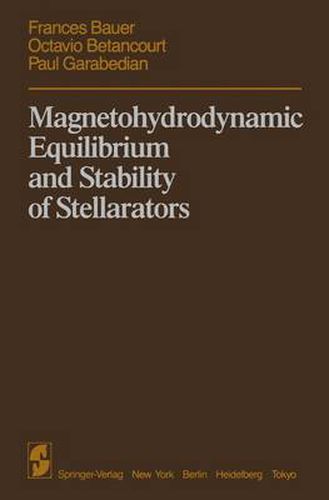Readings Newsletter
Become a Readings Member to make your shopping experience even easier.
Sign in or sign up for free!
You’re not far away from qualifying for FREE standard shipping within Australia
You’ve qualified for FREE standard shipping within Australia
The cart is loading…






This title is printed to order. This book may have been self-published. If so, we cannot guarantee the quality of the content. In the main most books will have gone through the editing process however some may not. We therefore suggest that you be aware of this before ordering this book. If in doubt check either the author or publisher’s details as we are unable to accept any returns unless they are faulty. Please contact us if you have any questions.
In this book, we describe in detail a numerical method to study the equilibrium and stability of a plasma confined by a strong magnetic field in toroidal geometry without two-dimensional symmetry. The principal appli cation is to stellarators, which are currently of interest in thermonuclear fusion research. Our mathematical model is based on the partial differential equations of ideal magnetohydrodynamics. The main contribution is a computer code named BETA that is listed in the final chapter. This work is the natural continuation of an investigation that was presented in an early volume of the Springer Series in Computational Physics (cf. [3]). It has been supported over a period of years by the U.S. Department of Energy under Contract DE-AC02-76ER03077 with New York University. We would like to express our gratitude to Dr. Franz Herrnegger for the assistance he has given us with the preparation of the manuscript. We are especially indebted to Connie Engle for the high quality of the final typescript. New York F. BAUER October 1983 O. BETANCOURT P. GARABEDIAN Contents 1. Introduction 1 2. Synopsis of the Method 3 1. Variational principle 3 2. Coordinate system 6 3. Finite Difference Scheme 8 1. Difference equations …………………..
8 2. Island structure ……………………….. 10 3. Accelerated iteration procedure ………….… .. 12 Nonlinear Stability 15 4. 1. Second minimization … … … … … . .… 15 … . . 2. Test functions and convergence studies … … . .… 17 . 3. Comparison with exact solutions …………….. 19 5. The Mercier Criterion 22 1. Local mode analysis … … … … … . .… 22 … . . 2. Computational method … … … … … .… 23 … .
$9.00 standard shipping within Australia
FREE standard shipping within Australia for orders over $100.00
Express & International shipping calculated at checkout
This title is printed to order. This book may have been self-published. If so, we cannot guarantee the quality of the content. In the main most books will have gone through the editing process however some may not. We therefore suggest that you be aware of this before ordering this book. If in doubt check either the author or publisher’s details as we are unable to accept any returns unless they are faulty. Please contact us if you have any questions.
In this book, we describe in detail a numerical method to study the equilibrium and stability of a plasma confined by a strong magnetic field in toroidal geometry without two-dimensional symmetry. The principal appli cation is to stellarators, which are currently of interest in thermonuclear fusion research. Our mathematical model is based on the partial differential equations of ideal magnetohydrodynamics. The main contribution is a computer code named BETA that is listed in the final chapter. This work is the natural continuation of an investigation that was presented in an early volume of the Springer Series in Computational Physics (cf. [3]). It has been supported over a period of years by the U.S. Department of Energy under Contract DE-AC02-76ER03077 with New York University. We would like to express our gratitude to Dr. Franz Herrnegger for the assistance he has given us with the preparation of the manuscript. We are especially indebted to Connie Engle for the high quality of the final typescript. New York F. BAUER October 1983 O. BETANCOURT P. GARABEDIAN Contents 1. Introduction 1 2. Synopsis of the Method 3 1. Variational principle 3 2. Coordinate system 6 3. Finite Difference Scheme 8 1. Difference equations …………………..
8 2. Island structure ……………………….. 10 3. Accelerated iteration procedure ………….… .. 12 Nonlinear Stability 15 4. 1. Second minimization … … … … … . .… 15 … . . 2. Test functions and convergence studies … … . .… 17 . 3. Comparison with exact solutions …………….. 19 5. The Mercier Criterion 22 1. Local mode analysis … … … … … . .… 22 … . . 2. Computational method … … … … … .… 23 … .